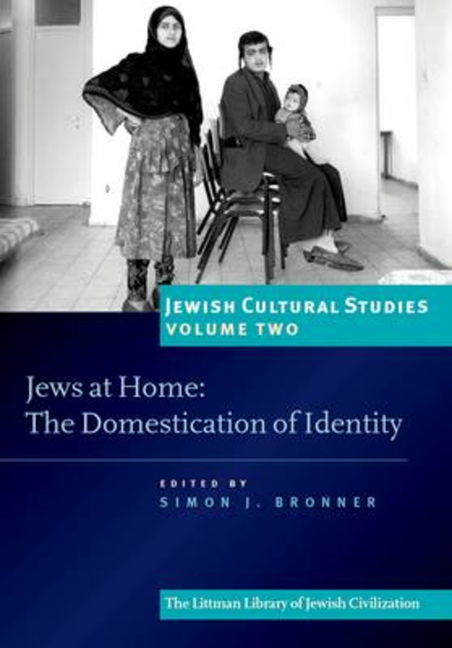Book contents
- Frontmatter
- Dedication
- Miscellaneous Frontmatter
- Acknowledgements
- Contents
- Note on Transliteration
- Introduction: The Dualities of House and Home in Jewish Culture
- PART I IN AND OUT OF THE HOME
- PART II SACRED, SECULAR, AND PRO FANE IN THE HOME
- PART III WRITING HOME
- PART IV FORUM: FEELING AT HOME
- INTRODUCTION
- RESPONSES
- 11 At Home in the World
- 12 The Co-Construction of Europe as a Jewish Home
- 13 Reflections on ‘Culture Mavens’ from an Australian Jewish Perspective
- 14 There's No Place Like Home: America, Israel, and the (Mixed) Blessings of Assimilation
- 15 The Last Word: A Response
- Contributors
- Index
13 - Reflections on ‘Culture Mavens’ from an Australian Jewish Perspective
from RESPONSES
- Frontmatter
- Dedication
- Miscellaneous Frontmatter
- Acknowledgements
- Contents
- Note on Transliteration
- Introduction: The Dualities of House and Home in Jewish Culture
- PART I IN AND OUT OF THE HOME
- PART II SACRED, SECULAR, AND PRO FANE IN THE HOME
- PART III WRITING HOME
- PART IV FORUM: FEELING AT HOME
- INTRODUCTION
- RESPONSES
- 11 At Home in the World
- 12 The Co-Construction of Europe as a Jewish Home
- 13 Reflections on ‘Culture Mavens’ from an Australian Jewish Perspective
- 14 There's No Place Like Home: America, Israel, and the (Mixed) Blessings of Assimilation
- 15 The Last Word: A Response
- Contributors
- Index
Summary
AS I WAS GROWING UP in Sydney in the late 1950s, there was a saying that Australia was at least a decade behind America in all aspects of life, including technology, fashion, and entertainment trends. Reading Jenna Weiss man Joselit's essay ‘Culture Mavens’ on the way that Americans feel at, and about, their home, I felt that Australian Jewry was not only a decade but possibly a whole generation behind American Jewry, if not more. I found it difficult to relate to the picture she was describing as, on the whole, Australian Jewry is still much more traditional in its Jewish lifestyles and choices. The largely religious Jewish day school movement, which attracts a high proportion of Jewish children, is a major factor affecting home practice, decoration, and observance in Australia. Since there is a clear nexus between home and school, this adds to the distinctive element of Australian Jewry. In addition, the community is still largely an immigrant community, strongly informed by the Holocaust and Israel, and does not demonstrate the same varieties of Judaism that she describes. Certainly, the community has not experienced a ‘revolution’ since the watershed years of post-war survivor migration, the major transformative period of Australian Jewry, but rather an ongoing evolution since the 1960s, which has reinforced a range of Jewish experiences and approaches and has been reinvigorated by the more recent waves of immigrants, particularly from South Africa (Rutland 2001).
Traditionally, Australian Judaism was much more conservative than American Judaism, which historically was characterized by the rise of Reform Judaism and other movements which focused on cultural Judaism (Gurock 2008; Sarna 2004). Influenced by Australia's colonial connection to Britain in the nineteenth century, Australian Jewry assumed the assimilationist attitude attributed to Anglo-Jewry of being a Jew on the sabbath and a member of the general population for the rest of the week. Thus the community practised a diluted form of Orthodoxy, which had a major impact on home life. Few Jews out of the small Jewish population of 23,000 in 1933 strictly followed kashrut laws, and there were no specifically kosher shops. Kosher meat was sold at a separate counter at the non kosher butcher.
- Type
- Chapter
- Information
- Jews at Home , pp. 307 - 315Publisher: Liverpool University PressPrint publication year: 2010



